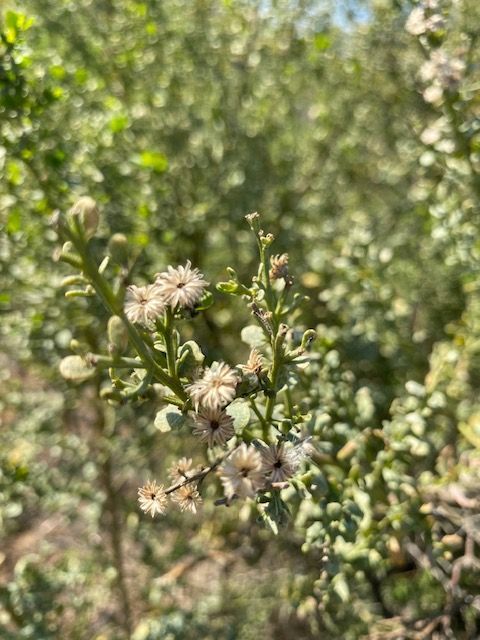Science Corner - Coyote Bush

Coyote Bush (Baccharis pilularis) is one of my very favorite California native plants. It’s found throughout California and is a commonly seen but perhaps unnoticed species in our region. It seems nobody can quite agree on exactly why its common name is coyote bush but like another California native, the Coyote (Canis latrans) it is a very adaptable species and can thrive in many environments. Like the four-legged coyote, Coyote Bush flourishes in hot and arid chaparral, it can be an occasional woody plant in the grasslands of California, a common understory species in our oak woodlands and riparian areas and a soil stabilizing friend on windy coastal slopes. It can colonize in the shade but really thrives in full sun and pretty much everything else in between. It is able to endure soil and weather conditions that not many other species can ride out.
Although the source of the name isn’t really known, some believe that it may have come from both species’ adaptability or their ecological partnership, while others think it may be from the shape of the leaves which maybe *kinda sorta* resemble a coyote’s paw if you squint a bit.
Oh, and the smell! I don’t mean to gush but I have such a fondness for the scent of Coyote Bush and catching a whiff of it positively brightens my day. Falling in line with its often underrated and underappreciated presence, I often notice the presence of Coyote Bush by its scent before I even see the plant. I’ve heard it described as smelling like sage, honey, hay, sea air and even soap but to me it smells like pure glee with a dash of spice, dill and fresh air. I wish someone would make a Coyote Bush scented candle but I’m not sure that could do it justice.
Coyote Bush is a member of the Asteraceae (Aster) family which includes other favorites such as daisies, sunflowers, marigolds, dandelions and about 32,000 other known species worldwide. It is the largest family of flora in North America. Members of the Aster family have an enormous distribution and occur in subpolar to tropical regions and on every continent except Antarctica. Most members of the Aster family are herbaceous but some species can occur as an annual (completes its life cycle in one year), a biennial (completes its life cycle in two years) or a perennial (lives two or more years) and as woody vines, shrubs or trees. Flowers of the Aster family consist of many tiny florets (disk flowers) surrounded by strap-like bracts (also called ray flowers) which creates the characteristic “sunflower” look.
Coyote Bush is a perennial shrub usually less than ten feet tall with many stiff, upright branches and an extensive root system including dense lateral roots and a tap root that may be as long as the shrub is tall. The leaves are bright green, about an inch long with toothed margins and are broadest at the tip. They are covered with surface glands that produce resinous, but not sticky, oils which is where the fabulous scent comes from. This resin helps the plant decrease water loss through its leaves.
Coyote Bush is dioecious which means that male and female flowers on separate plants. Most of the year the shrub looks bright green but when it flowers from late summer to late fall it can look somewhat creamy white because of the multitude of tiny flowers. The flowers are pollinated by a variety of insects and in late fall and early winter a gazillion (probably not really that many but pretty close) itsy-bitsy (less than 1/16th of an inch) seeds are released and float away on a puff of fluff like another well-known Aster, the dandelion. Shrubs are most noticeable before and during seed dispersal when they appear ashy white because of the superabundance of tuft and seeds. Although Coyote Bush is popular in native landscaping, people usually only use male plants to avoid the messy seed dispersal.
Coyote Bush is somewhat burn resistant due to the high concentrations of fire-retardant organic compounds in its leaves. If the shrub does burn the root crown usually survives and will resprout. Because the many seeds of Coyote Bush are wind-blown with a wide dispersal area it will also readily re-establish itself in post burn and other disturbed areas. It is also deer and graze resistant and drought tolerant.
Other fun facts about Coyote Bush:
- Coyote Bush often supports galls created by a host-specific midge (Rhopalomyia californica) that look like tiny cauliflowers.
- Coyote Bush is often called a “pioneer species” because it is one of the first to re-establish following a fire or flood.
- Coyote Bush provides an important source of nectar and habitat for native birds and butterflies.
-Kristie Ehrhardt (kehrhardt@tuleyome.org)
Tuleyome Land Conservation Program Manager
RECENT ARTICLES






